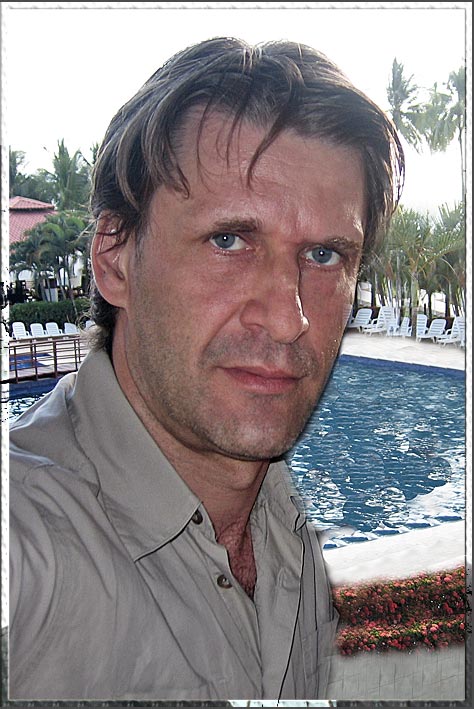About me
I was born in beautiful Erfurt, today's state capital of Thuringia.My "career" as a photographer began in Güstrow on my 11th birthday with a POUVA SL 100, a present from my dear mother.
I graduated from high school in Greifswald, because my family decided to build a house at the Baltic Sea.
From 1986 to 1991 I studied camera at the film school in Potsdam-Babelsberg, a wonderful time.
I was particularly fascinated by the real world. From the beginning of my studies, I was drawn to documentary formats and to other countries.
In 1990, the second international SACRED RUN from London to Moscow also passed through Potsdam. The Potsdam photographer Henry Notroff spontaneously joined this run for land and life under the spiritual guidance of Dennis J. Banks, a founder of the American Indian Movement AIM, all the way to Moscow. He had told me about the runners' arrival in Potsdam. I captured scenes with a Super 8 camera. When he came back he was so enthusiastic about his participation in this run that I decided to make a film about one of the next runs. In 1993 I accompanied the SACRED RUN, again with Dennis Banks as spiritual guide, through Australia and New Zealand (Aotearoa) with a professional video camera. This resulted in my first own documentary film in 1994, the poetic documentary "Sacred Run through Sacred Land".
At about the same time I met Ralf Marschalleck, director and one of the managing directors of the Berlin company UmWeltFilm, and realized three documentaries with him as his cameraman from 1993 to 1996. These were two commissions for public television stations, which we shot with the Makah on the US West Coast. The third commissioned work was a portrait of a German-Romanian family in Transylvania.
The most beautiful article about me and our association to support indigenous peoples (in german)
In 1995 I ended up in the Philippines and Thailand because Hartmut Heller, the then chairman of the international association FREUNDE DER NATURVÖLKER (Friends of Peoples Close to Nature), had asked me to help him report on the fate of Southeast Asian natives, so-called Negritos. I met Nenita Templo, who accompanied us to a community of the Aeta people affected by the volcanic eruption of Pinatubo in 1991. From the footage shot in Thailand among the Mani, two short reports were made for German television stations. I visited Nenita and the Aeta in the Philippines several times in the following years, out of love and friendship. A lot of video material was created during this time, which I would like to process into a long-term documentation.
The Aeta of Lumibao - An article by Daniela Waldmann (in german)
In 1997, I got to know Berlinale Golden Bear winner Rainer Simon personally. I had approached him with the proposal to realize film projects together. The result was a documentary film with the Sápara Indígenas in Ecuador, which we were able to sell to ARTE via ORB, and which was later also broadcast on 3sat and in many third programs of ARD. In 2000 (final production in 2002), we created a semi-documentary feature film with the Chachi of Ecuador's Pacific coast of Esmeraldas province, a docuficción, a genre also used by indigenous people to preserve their legends audiovisually.
Also in 2000, a fruitful collaboration began with the author, director and journalist Eckart Lottmann. Two parts of a documentary about the work of Berlin street workers and a film about the Berlin district Heinersdorf were produced. Unfortunately, Eckart passed away in February 2020 after a long and serious illness. His death touched me deeply and left a painful gap.In 2004, a film project by Zé do Rock brought me to southern Brazil. By 2008, a 95-minute docu comedy was created from the filmed material, which was shown in several cinemas and many other places until 2010.
In 2002 I met Lorena Tello in Ecuador. In 2004 her son Freddy also came to Germany. I observed this change of life for many years with different cameras. This should also become a long-term documentary.
Other documentary works were made with different directors, and finally my second own film, the SLOWCUMENTARY "I'm Martha, Colombian". I created this genre. It should make it easier to classify the film, which I would describe as a slow author's documentary. In the three hours of its duration, Martha has plenty of time to talk about herself and her life. However, in two lengthy conversations with her, you can also learn a lot about Afro-Colombian culture in particular and Colombia and the world in general. Martha amazed me again and again with surprising statements. Thanks to her and her three sisters Yulisa, María and Yasnury, I was able to immerse myself for several weeks in their world, which was unknown to me until then, in their own cosmos, which is only seemingly foreign and exotic. The similarities prevail. I would like to thank them very much and all the others who helped me to get these insights, especially my friends from Ecuador, in particular Alejandro Santillán Magaldi.
Influenced by my experiences with and reports about indigenous peoples all over the world, I founded the non-profit association LEBENDIGE ERDE - SACRED EARTH e.V. in 1997 to support indigenous peoples. We mainly help people in need in Ecuador, Colombia and the Philippines.